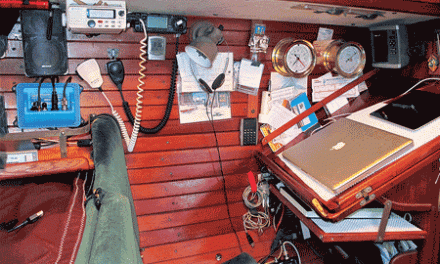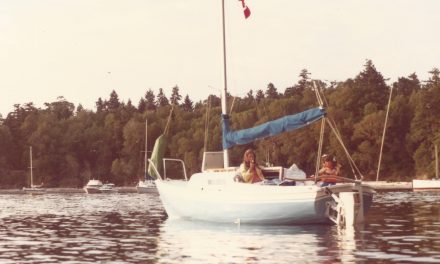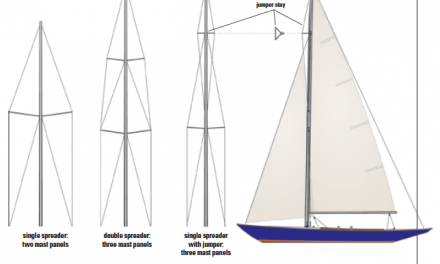How to transform that lukewarm solar shower into heated comfort
Issue 149: March/April 2023
Like many sailors, I have a sun shower solar hot water heater. Over the years, I’ve found that it works well in bright sun and light winds, but there are two problems with it: First, if there’s a lot of wind, the sun shower loses heat faster than it can absorb it. Second, if the sun is blocked by a cloud or it’s late in the day, the sun shower won’t gain any heat but will lose it to the surrounding air, especially if there is a breeze. The plastic bag the sun shower is made of has no insulation and can’t retain the heat.

An initial solution involved creating a wind
shield around the shower to protect it from wind.
Since we usually want to shower after coming back from the beach or bicycling, the temperature of the water is often inadequate for a comfortable shower, and I have to add boiling water. This is frustrating, since I know that the water in the sun shower was hot earlier in the day but lost that heat as the sun got lower or the breeze kicked up.
I found a partial solution by taking a piece of Plexiglas about 6 to 8 inches wide by about 5 feet long and drilling a hole at each end. I fasten the ends together with a harness clip to form an oval, and place that around the sun shower. This wind shield deflects the breeze and helps to keep the sun shower warmer on windy days. When I’m not using the shield, I unclip the ends and put the Plexiglas strip under a berth cushion where it’s out of the way.
This, however, doesn’t help much when the sun is obscured by passing clouds or gets lower in the sky at the end of the day. I felt that there had to be a better way.

The new system uses tubing sandwiched between foam and Plexiglas for heat retention.
My latest attempt uses 20 feet of ¼-inch ID clear plastic tubing, some connectors, and a piece of closed-cell foam about 1 foot square. I used the interior foam from an old boat cushion and painted it black. I then connected two lengths of the plastic tubing with connectors and formed the tubing into a double spiral glued down to the square of black foam. This required making one length of tube longer than the other because the outer coil of the spiral has to go farther than the inner coil. I then put a square of clear Plexiglas over the glued-down tubing to make a sandwich with the blackpainted foam on the bottom, the spiral of plastic tubing in the middle, and the clear Plexiglas on top. After initial testing showed that the system worked, I glued the sandwich together to make it easier to handle and store.
Next, I bought a small solar-powered water pump, the type made for outdoor ornamental fountains. It cost around $20, has a solar panel about 6 x 6 inches, and the pump is submersible. I also bought a 1-gallon insulated jug to store the hot water. The one I found was perfect, since it has a large screw-on opening through which the pump body will fit, and also a smaller spigot with a screw-on lid through which the tubing and wire will fit.
I had to cut the wire between the pump and its solar panel because neither would fit through the small spigot opening, and I wanted the larger lid to remain closed when the unit is in use. Instead, I used a standard wire plug connector for the wire that could be fed through the small spigot opening.
To use the system, I put the pump inside the jug and feed the wire plug up through the spigot. I feed both tubes down through the spigot, connecting one of them to the outlet of the pump (the discharge end) and leaving the other one for returning the heated water into the jug. I then connect the wire to the solar panel using the plug.

A 1-gallon insulated jug with a pump inside stores the hot water until it is used.
I fill the jug with water, which is circulated via the pump through the spiral tubing, where it is warmed by the sun and protected from heat loss. Then the water is directed back into the jug to be stored until it’s used.
The first time I used the system, the water in the jug reached 120 degrees, which was as high as my thermometer could measure. This was after only a few hours of sunlight. When the sun is blocked or gets too low, the pump stops and the insulated jug keeps the hot water from losing heat even on a windy day. I bought a black jug without much thought, but discovered that on a sunny day, the jug itself gets hot. When we’re ready for a shower, we pour that hot water into the sun shower or more commonly, save it to wash dishes after dinner. The water stays hot for hours. When not in use, the whole system goes in a bag and fits in a locker. I haven’t yet tested the system during the cool autumn days, but it should certainly work better than the sun shower.
I’ve often wondered why boats aren’t designed with a built-in system like this that connects to the boat’s hot water heater tank. A flushmounted solar water collector and matching photovoltaic panel mounted into the deck would provide hot water when the sun was shining and reduce the need to run the engine or a generator to make hot water.
Maybe some boat designer will eventually do that, but meanwhile, my system works just fine.
Mark Branse bought his first boat, a rowboat, at age 12 with money he saved from his allowance and odd jobs around the neighborhood. He and his wife, Linda, bought and restored a neglected 32- foot steel sloop but lost it in Hurricane Gloria in 1985. They now sail their 1967 Morgan 34, Rigoler, which they have extensively refitted, out of Mystic, Connecticut.
Thank you to Sailrite Enterprises, Inc., for providing free access to back issues of Good Old Boat through intellectual property rights. Sailrite.com





